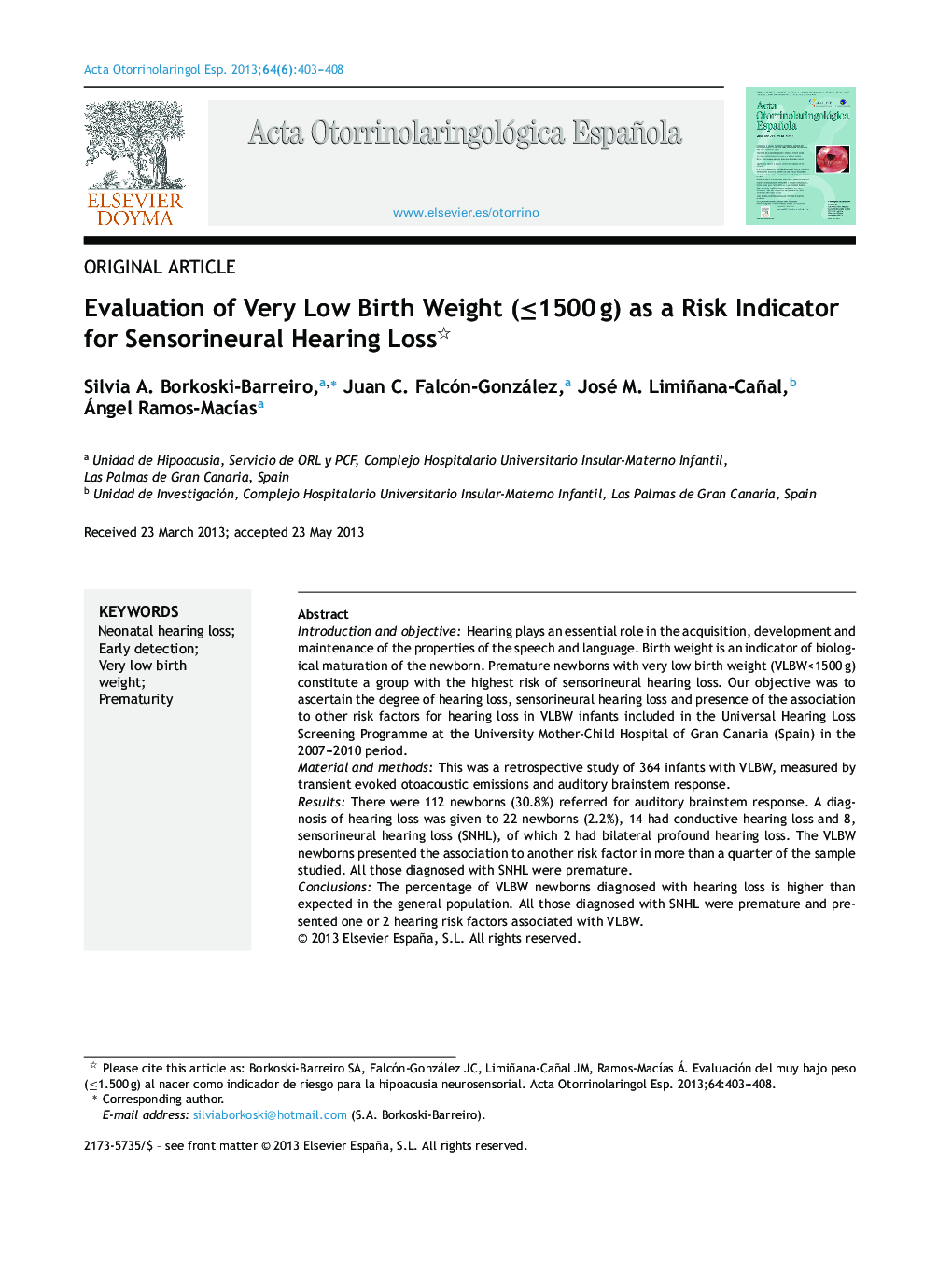| کد مقاله | کد نشریه | سال انتشار | مقاله انگلیسی | نسخه تمام متن |
|---|---|---|---|---|
| 4100738 | 1268725 | 2013 | 6 صفحه PDF | دانلود رایگان |

Introduction and objectiveHearing plays an essential role in the acquisition, development and maintenance of the properties of the speech and language. Birth weight is an indicator of biological maturation of the newborn. Premature newborns with very low birth weight (VLBW<1500 g) constitute a group with the highest risk of sensorineural hearing loss. Our objective was to ascertain the degree of hearing loss, sensorineural hearing loss and presence of the association to other risk factors for hearing loss in VLBW infants included in the Universal Hearing Loss Screening Programme at the University Mother-Child Hospital of Gran Canaria (Spain) in the 2007–2010 period.Material and methodsThis was a retrospective study of 364 infants with VLBW, measured by transient evoked otoacoustic emissions and auditory brainstem response.ResultsThere were 112 newborns (30.8%) referred for auditory brainstem response. A diagnosis of hearing loss was given to 22 newborns (2.2%), 14 had conductive hearing loss and 8, sensorineural hearing loss (SNHL), of which 2 had bilateral profound hearing loss. The VLBW newborns presented the association to another risk factor in more than a quarter of the sample studied. All those diagnosed with SNHL were premature.ConclusionsThe percentage of VLBW newborns diagnosed with hearing loss is higher than expected in the general population. All those diagnosed with SNHL were premature and presented one or 2 hearing risk factors associated with VLBW.
ResumenIntroducción y objetivoLa audición cumple un rol fundamental en la adquisición, desarrollo y mantenimiento de las propiedades del habla y del lenguaje. El peso al nacer es un indicador de maduración biológica del recién nacido (RN). El RN con muy bajo peso al nacer (MBPN ≤ 1500 g) y el gran prematuro es un grupo de población de mayor riesgo para hipoacusia neurosensorial. El objetivo del estudio es conocer el grado de hipoacusia, presencia de hipoacusia neurosensorial y la asociación a otro factor de riesgo para hipoacusia en el RN de MBPN, incluidos en el Programa de Cribaje Universal de la Hipoacusia del Complejo Hospitalario Universitario Insular Materno Infantil de Gran Canaria, período 2007–2010.Material y métodoEstudio retrospectivo de 364 RN con MBPN, mediante otoemisiones acústicas provocadas transitorias y potenciales evocados auditivos de tronco cerebral.ResultadosCiento doce RN (30.8%) fueron derivados a potenciales evocados auditivos de tronco cerebral. Veintidós RN (2,2%) presentaron diagnóstico de hipoacusia, 14 hipoacusias de transmisión, 8 hipoacusias neurosensoriales (HNS), y de estos, 2 con hipoacusia profunda bilateral. La asociación a otro factor de riesgo de los RN con MBPN se presenta en más de la cuarta parte de la muestra estudiada. Todos los diagnosticados de HNS fueron grandes prematuros.ConclusionesEl porcentaje de niños con diagnóstico de hipoacusia entre los RN con MBPN es superior al esperado en la población general. Todos los diagnosticados de HNS fueron grandes prematuros y presentaban uno o 2 factores de riesgo auditivo más, asociados al MBPN.
Journal: Acta Otorrinolaringologica (English Edition) - Volume 64, Issue 6, November–December 2013, Pages 403–408